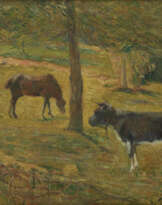ID 1051688
Lot 117 | Paul Gauguin (1848-1903)
Estimate value
€ 80 000 – 120 000
L'Angelus en Bretagne
monogrammé 'PGO' au pinceau et à l'aquarelle (en bas à droite du sujet); dédicacé, signé et daté à la plume et à l'encre 'for my friend O'Conor / one man of Samoa / P. Gauguin 1894' (en bas à droite du support)
monotype à l'aquarelle sur vélin fort contrecollé par l'artiste sur un support de présentation
Image: 27.5 x 30 cm.
Support de présentation: 37.5 x 38 cm.
Exécuté en 1894
monogrammed 'PGO' in brush and watercolour (lower right subject); dedicated, signed and dated in pen and ink 'for my friend O'Conor / one man of Samoa / P. Gauguin 1894' (lower right of mount)
watercolour monotype, on heavy wove paper laid on a presentation mount by the artist
Image: 10 ¾ x 11 ¾ in.
Presentation mount: 14 5⁄8 x 15 in.
Executed in 1894
Provenance
Roderic O'Conor (un cadeau de l'artiste en 1894).
Madame Henrietta O'Conor; vente, Hôtel Drouot, Paris, 6 et 7 février 1956, lot 17R.
G. Michel.
M. et Mme. Marvin Small, New York.
Ira Gale, Londres.
Vente, Palais Galliera, Paris, 16 juin 1969, lot 11.
Sam Josefowitz, Pully.
Puis par descendance aux propriétaires actuels.
Literature
R. Pickvance, Gauguin Drawings, London, 1969, p. 91.
Richard S. Field, Paul Gauguin: Monotypes, Philadelphia, 1973, no. 25 (illustré en couleurs p. 14).
Wladyslawa Jaworska, Gauguin and the Pont Aven School, Greenwich, Conneticut, 1972, p. 225.
Roderic O'Conor, 1860-1940, cat. exp., Londres et Belfast, 1985, p.14 (illustré, fig.4).
R. Johnston, Rodéric O’Conor 1860-1940, Barbicane Art Gallery, Londres et Ulster Museum, Belfast, 1985, n°14 (illustré).
Caroline Boyle-Turner, The Prints of the Pont-Aven School: Gauguin and his circle in Brittany, Smithsonian Institution Traveling Exhibition Service, Washington, 1986, p. 116.
Y. le Pichon, Sur les traces de Gauguin, Paris, 1986, p. 194 (illustré en couleurs).
J. Benington, Roderic O'Conor: A Biography, with a Catalogue of his Work, Dublin, 1992, p. 59, no. 22a (illustré).
Gauguin: Les XX et la Libre Esthétique, cat. exp., Musée d'Art Moderne et d'Art Contemporain, Liège, 1994-1995, p.23 et 108 (illustré).
D. Delouche, Gauguin et la Bretagne, Jouve, 1996, p. 122, no. II (illustré en couleurs).
B. Frelaut, La merveilleuse Bretagne des peintres, Genève, 2002, p. 85 (illustré).
N. M. Mathews, Paul Gauguin, An Erotic Life, New Haven and London, 2001, p. 202 (illustré en couleurs).
T. Dussard, E. Eckermann, Dans le sillage de Gauguin, Un voyage de Pont-Aven à Tahiti, Avignon, 2003, p.66 (illustré en couleurs, p. 67).
Exhibited
London, Tate Gallery, Gauguin and the Pont-Aven Group, janvier-février 1966, no. 65.
New York, The Solomon R. Guggenheim Foundation, Gauguin and the Decorative Style, 1966 (sans numéro).
Philadelphia, Philadelphia Museum of Art, Paul Gauguin: Monotypes, mars-mai 1973, no. 25 (illustré en couleurs p. 14).
New York, Museum of Modern Art, The Prints of the Pont-Aven School: Gauguin and his circle in Brittany, mai - juillet 1987 (sans numéro; leur étiquette au verso).
Washington, National Gallery of Art; Chicago, Art Institute of Chicago, and Paris, Grand Palais, The Art of Paul Gauguin, Avril 1988-Avril 1989, p. 351, no. 191 (illustré en couleurs).
Liège, Musée d’Art Moderne et d’Art Contemporain de la ville de Liège, Gauguin, les XX et la libre Esthétique, 21 octobre 1994 – 15 janvier 1995 (sans numéro), (illustré).
Further details
Cette œuvre charmante est directement liée à un tableau que Gauguin a exécuté en 1894 en Bretagne, Jeune fille chretienne (coll. Clarke Art Institute, Williamstown, Mass.). Il a réalisé la présente œuvre pour Roderic O'Conor, l'artiste irlandais rencontré à Pont-Aven, dont il espérait qu'il l'accompagnerait à Tahiti. Mais O'Conor change d'avis et Gauguin retourne seul à Tahiti. Dans de nombreux cas, Gauguin emprunte une composition, une figure ou une partie de la composition d'un tableau comme base d'un transfert. Il a rarement fait l'inverse, c'est-à-dire qu'il a agrandi le tableau pour traduire l'image, comme il l'a fait ici. Seule la jeune fille rousse à la robe jaune se trouve dans le tableau ; ni ses compagnes, soigneusement habillées en costume breton, ni le grand paysage, dérivé par Gauguin d'un transfert perdu (champ 28), ne sont ici. La traduction en transfert de couleur donne à la composition la qualité d'une miniature. Gauguin avait fait un bref voyage en Belgique en février 1894 avant de réaliser cette œuvre - peut-être les figures de profil des jeunes filles bretonnes sont-elles dérivées des figures de donateurs dans les peintures flamandes du quinzième siècle qu'il avait vues là-bas. Ici, elles prient avec la jeune fille dont la position au centre de ce trio de priantes lui donne le caractère d'une image de dévotion" (The Art of Paul Gauguin, cat. exp., Washington, D. C., Chicago et Paris, 1988, p. 351).
This charming work relates directly to a painting Gauguin executed in 1894 in Brittany (coll. Clarke Art Institute, Williamstown, Mass.). He made the present work for Roderic O'Conor, the Irish artist he met in Pont-Aven who he had hoped would accompany him to Tahiti. However, O'Conor changed his mind, and Gauguin returned to Tahiti alone. In many cases, Gauguin borrowed a composition, a figure, or a portion of a composition from a painting as the basis for a transfer. He rarely did the opposite, that is enlarge upon the painting when translating the image, as he did here. Only the red-haired girl in the yellow dress can be found in the painting; neither of her companions, carefully dressed in Breton costume, nor the large landscape setting, derived by Gauguin from a lost transfer (Field 28), are here. The translation into a colour transfer gives the composition the quality of a miniature. Gauguin had made the brief trip to Belgium in February of 1894 before this work was made - perhaps the profile figures of the Breton girls were derived from donor figures in fifteenth-century Flemish paintings he had seen there. Here, they pray with the young girl whose position in the center of this trio of praying girls gives her the character of a devotional image' (The Art of Paul Gauguin, cat. exp., Washington, D. C., Chicago et Paris, 1988, p. 351).
| Artist: | Paul Gauguin (1848 - 1903) |
|---|---|
| Applied technique: | Monotypе |
| Medium: | Acrylic glass, Plastic |
| Place of origin: | Western Europe, France, Europe |
| Artist: | Paul Gauguin (1848 - 1903) |
|---|---|
| Applied technique: | Monotypе |
| Medium: | Acrylic glass, Plastic |
| Place of origin: | Western Europe, France, Europe |
| Address of auction |
CHRISTIE'S 9 Avenue Matignon 75008 Paris France | ||||||||||||||
|---|---|---|---|---|---|---|---|---|---|---|---|---|---|---|---|
| Preview |
| ||||||||||||||
| Phone | +33 (0)1 40 76 85 85 | ||||||||||||||
| Fax | +33 (0)1 40 76 85 86 | ||||||||||||||
| Conditions of purchase | Conditions of purchase | ||||||||||||||
| Shipping |
Postal service Courier service pickup by yourself | ||||||||||||||
| Payment methods |
Wire Transfer | ||||||||||||||
| Business hours | Business hours
|





![[JARRY, Alfred (1873-1907) et Remy de GOURMONT (1858-1915), éd.]](/assets/image/picture_3807179/db0f3/9f8a9c9f9f96b44499182a8f6613e35b1710234000jpg__fix_162_205.jpeg)
![[REVUES]](/assets/image/picture_3807250/6bf13/dc3db82894376503e72508d2fd423b8b1710234000jpg__fix_162_205.jpeg)







